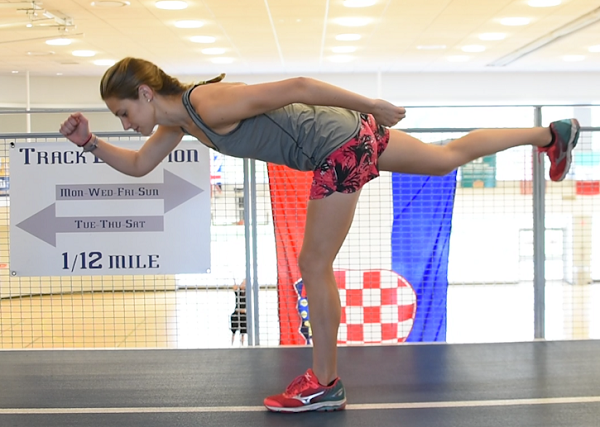Dynamic Warm-up for Runners
November 30, 2017
What is the best way to warm up before running?
How to do a dynamic warm-up and why you should.
Many runners believe that stretching muscles before running is a good idea. A commonly held belief is that loosening up your muscles will get them ready for a run and will help prevent injuries. What the research tells us is quite the opposite. Static stretching, where you hold the muscle in a lengthened position for anywhere from 10 seconds up to a minute, does affect the responsiveness of the muscle but probably not in the way we would expect.  Due to a reflex that is triggered when a muscle is lengthened, static stretching causes a decrease in the excitability or reactivity of a muscle. This reduces the effectiveness of the muscle to respond rapidly as it becomes inhibited or relaxed. Research suggests that some amount of leg stiffness may be beneficial to improve running efficiency. The muscle can then be used as a spring, absorbing energy as it is compressed and using it to recoil for an effective push off against the ground in order to move your body forward efficiently. A study published in The Journal of Strength and Conditioning showed that static stretching prior to running actually led to an increase in energy cost of running and a negative impact on performance in a group of runners compared to a no stretching situation. The runners became less efficient and covered less distance in a prescribed amount of time if they did static stretching before the run. Static stretching decreases the ability of muscle to generate force, affecting strength and endurance. This is not what you want to do before a race or a training run.
Due to a reflex that is triggered when a muscle is lengthened, static stretching causes a decrease in the excitability or reactivity of a muscle. This reduces the effectiveness of the muscle to respond rapidly as it becomes inhibited or relaxed. Research suggests that some amount of leg stiffness may be beneficial to improve running efficiency. The muscle can then be used as a spring, absorbing energy as it is compressed and using it to recoil for an effective push off against the ground in order to move your body forward efficiently. A study published in The Journal of Strength and Conditioning showed that static stretching prior to running actually led to an increase in energy cost of running and a negative impact on performance in a group of runners compared to a no stretching situation. The runners became less efficient and covered less distance in a prescribed amount of time if they did static stretching before the run. Static stretching decreases the ability of muscle to generate force, affecting strength and endurance. This is not what you want to do before a race or a training run.
Another reason to reconsider pre-run stretching is that research has demonstrated that static stretching before a run does not decrease injury risk for runners. Results from a USA Track & Field-sponsored study analyzing nearly 3,000 runners confirm there is no difference in the risk of injury for those who stretched before running and those who did not. So it appears that stretching prior to running does not reduce the risk of injury and will likely have a negative impact on running performance. So what is the best way to prepare your body for running?
 Using a warm-up that prepares your muscles for the upcoming task should involve dynamic movements rather than static positions. This type of dynamic warm-up trains the muscles to activate in a way that simulates running movements but at a lower intensity level. Research comparing dynamic warm-ups to static stretching or no stretching situations demonstrate superior performance in the dynamic warm-up condition. Preparing your muscles to run by using running specific warm-up movements appears to be a better way to run more effectively. There are many benefits to utilizing a dynamic warm up prior to running.
Using a warm-up that prepares your muscles for the upcoming task should involve dynamic movements rather than static positions. This type of dynamic warm-up trains the muscles to activate in a way that simulates running movements but at a lower intensity level. Research comparing dynamic warm-ups to static stretching or no stretching situations demonstrate superior performance in the dynamic warm-up condition. Preparing your muscles to run by using running specific warm-up movements appears to be a better way to run more effectively. There are many benefits to utilizing a dynamic warm up prior to running.
Some of the benefits of a dynamic warm-up include:
-
increased body and tissue temperature
- increased circulation
- increased neural activation
- improved tissue extensibility and joint range of motion
- accentuated proprioception (body awareness)
All of these effects help prepare your body for more demanding activities. Dynamic movements can help prepare your body for greater load absorption and muscular force output required during running.
What is the best way to implement a dynamic warm-up? A very slow jog of three to five minutes can be used to increase muscle blood flow. This can be followed by six to ten minutes of progressive, dynamic movements. There are many movement patterns that can be utilized to reach all necessary running muscles and prepare them for activity. These movements should be through a comfortable range (not to end range). The movements should not be held statically and should not be painful. The movements should progressively load the tissues and become more ballistic as you progress from start to finish.
However, static stretching isn’t all bad it just depends on when it is done. After a run may be the best time for static stretching. If legs are tight and sore post-run, stretching is appropriate to decrease the excitability or tightness of the muscle to improve comfort and flexibility. It may be beneficial after the run, but not before.
Watch the Dynamic Warm-up Program video.
Visit the Drexel University Running Performance and Research Center website.
 By Robert Maschi, PT, DPT, OCS CSCS
By Robert Maschi, PT, DPT, OCS CSCS
Associate Clinical Professor and Physical Therapist
Department of Physical Therapy and Rehabilitation Sciences
Drexel University Running Performance and Research Center